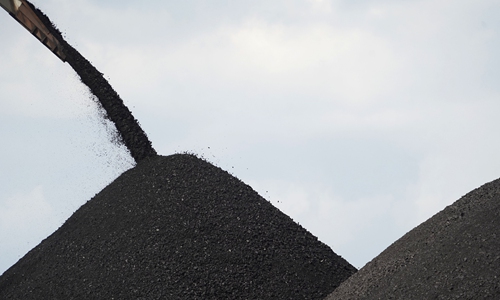
Coal Photo:CFP
China plans to increase its energy supply in 2022 by approving high-caliber coal mines with advanced production capacity, and promote construction of wind, solar, hydro and nuclear power projects.
At the same time, it will further increase the share of non-fossil fuel in total energy consumption.
Total energy production will reach about 4.41 billion tons of standard coal, 200 million tons of crude oil and 214 billion cubic meters (bcm) of natural gas in 2022, according to the energy work guidance for 2022 released by the National Energy Administration (NEA) on Tuesday.
The ramping up of domestic energy output comes amid rising and volatile global energy prices.
The production target has been raised from 4.2 billion tons of standard coal, 196 million tons of crude oil and 202.5 bcm of natural gas in 2021.
As one measure to ensure adequate electricity supply, NEA said it will approve high-quality coal mines with advanced production capacity in an orderly manner. The construction and operation of coal mines that are now under development will be accelerated.
In terms of new-energy power generation, the total installed capacity will reach about 2.6 billion kilowatts, and new-energy electricity generated will reach about 9.07 trillion kilowatt-hours by the end of 2022.
China will also commit to its dual carbon targets while ensuring power supply. It vows to continue to reduce coal consumption, and the share of non-fossil fuel in total energy consumption will rise to 17.3 percent, approaching the 20 percent target by 2025 set by the State Council.
Wind and photovoltaic power generation will account for about 12.2 percent of China's total electricity consumption in 2022.
China will continue to develop and build distributed photovoltaic rooftop facilities in counties and strengthen the supervision of implementation. It will also promote the construction of large-scale wind and photovoltaic power bases in deserts and other remote areas, along with the planning and construction of power transmission corridors.
Orderly progress will be made in major hydropower and nuclear power projects, including promotion of hydropower construction on the lower reaches of the Yarlung Zangbo River, and full operation of Baihetan Hydropower Station - the world's second-largest hydroelectric complex.
Total installed hydropower capacity will reach 410 million kilowatts.
The approval and construction of new coastal nuclear power projects will be promoted in an active and orderly manner while ensuring safety, said the NEA.
Global Times




